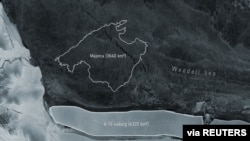The European Space Agency (ESA) says an enormous iceberg that recently split off from the western side of Antarctica is now the world’s largest.
The space agency says the iceberg, dubbed A-76, for the map quadrant of Antarctica in which it originated, is about 4,375 square kilometers in size -- slightly larger than the Spanish island of Majorca, and significantly larger than the U.S. state of Rhode Island.
The iceberg broke off from the Ronne Ice Shelf, in the Weddell Sea. Iceberg A-23, also in Weddell Sea, is now the world’s second largest at 3,880 square kilometers.
The Ronne Ice Shelf near the base of the Antarctic Peninsula is one of the largest of several enormous floating sheets of ice that connect to the continent's land mass and extend into surrounding seas.
In an interview with the Reuters news agency, University of Colorado at Boulder glaciologist Ted Scambos said large chunks of those shelves periodically break off as part of a natural cycle, and the break-off of A-76, which is likely to split into two or three pieces soon, is not linked to climate change.
Scambos said because the ice was already floating in the sea before dislodging from the coast, its breakaway does not affect ocean levels.
The ESA says the iceberg was first spotted by the British Antarctic Survey and confirmed by the U.S. National Ice Center, which captured images of it using the Copernicus Sentinel-1 Satellite.
The ESA says the Sentinel-1 mission consists of two polar-orbiting satellites that rely on C-band synthetic aperture radar imaging, returning data regardless of whether it is day or night, allowing year-round viewing of remote regions like Antarctica that are in darkness for much of the year.





